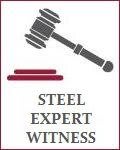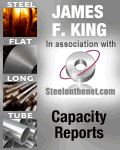Steel Industry Glossary of Terms: I-O
Technical glossary - jargon explained
| Term | Glossary Explanation |
| iBLUE® | Tenova technology that combines production of high carbon DRI using hydrogen from blast furnace grade iron ore pellets with electric arc melter to produce Hot Metal and granulated slag. |
| IISI | International Iron & Steel Institute. Former name of World Steel Association (WSA) - one of the leading world steel industry associations |
| Inclusion | Steel impurity - most often an oxide or a sulphide - which can have a detrimental impact on mechanical properties |
| Induction furnace | Furnace is which steel is heated by a process of induction, whereby electromagnetic coils that surround the furnace heat the steel by generation of eddy currents within the metal. Relatively speaking, the process is both very clean with respect to emissions and fairly enegy efficient |
| Ingot | Mass of metal obtained from casting liquid steel into a mould. The resulting ingot - a semi-finished product - is typically then hot rolled or forged |
| Interstitial-free | Interstitial-free (IF) steels have few solute interstitial elements, such as carbon and nitrogen. These interstices can be sources of strain and may result in brittleness |
| IPPC | Integrated Pollution Prevention and Control. To obtain an IPPC permit a business must prove that its applied technologies are equivalent or better than 'best available', as defined by the European Council Directive |
| JORC | Joint Ore Reserves Committee. The Australasian JORC Committee, established in 1971, sets out the JORC Code - a code of practice that defines international standards for public reporting of iron ore reserve data. |
| Killed steel | Steel that has its oxygen content reduced - typically through addition of aluminium. Hence the term aluminium killed |
| KPI | Key performance indicator. For example, EAF energy use in kWh/tonne is a widely-used melt shop performance indicator. |
| Ladle metallurgy | A process step typically applied in a ladle furnace for alloying, deoxidation, desulphurisation as well as for temperature adjustment prior to casting of quality steels |
| LDP | Definition in size terms varies but trade and other statistics frequently define large diameter pipe as over 16 inches (or 406.4mm) in diameter. Large pipe of this size is invariably welded rather than seamless, and can be produced by longitudinal or spiral welding for applications that often include gas and oil transport |
| LME | London Metal Exchange - leading non-ferrous metals market in the UK |
| LSAW | Longitudinal submerged arc welded pipe - a type of large diameter pipe, usually over 16 inches in diameter |
| Long ton | Measure of weight used in the UK prior to metrication. The long ton is equivalent to 2240 pounds or approximately 1016 kg. See also under glossary term short ton and tonne below |
| Merchant bar | A category of light long products comprising steel bars shaped as rounds, squares, hexagonals, rectangles, flats etc used mainly as support structures for building, construction, machinery. Merchant bar is to be distinguished from reinforcing bar (which is used to reinforce concrete) and from engineering steel (which often ends up moving rather than being stationery) |
| MHPT | Man hours per tonne - a common measure of labour force or process productivity |
| Micro mill | Term denoting a relatively small-scale EAF-based minimill, with production capacity at or below 250 kt / year. A particular characteristic of the micro mill is low cost steel supply. This is achieved by the small scale of the micro mill; by local scrap collection (thus avoiding high scrap transport costs); and by locating the micro mill close to steel end-users (again, avoiding high freight costs for the finished product) |
| Micum index | The percentages of coke remaining in a given size-band after rotating a coke sample within a drum for a given time. The index is a measure of the strength of coke against both impact and abrasion |
| MIDA | MIDA Mill: a low-capacity steel plant for regional markets that, thanks to its innovative technological solutions, can compete in term of CapEx and OpEx with steel plants with much higher capacity |
| Midrex ® | Direct reduction process for converting iron ore into direct reduced iron (DRI) for iron and steelmaking |
| Mild steel | Low carbon steel - often also referred to as soft steel. Carbon content generally under 0.25% |
| Mini mill | The term 'minimill' normally refers to a scrap-based EAF route steelmaking operation of relatively small scale (usually less than 500 kt capacity / year; thus much smaller than a typical BOF plant making several million t/yr) producing long products - although the concept is increasingly finding application in flat product mills. The word 'mini' is applied both because of the relatively small scale in volume terms and because of the relatively low capital cost per tonne involved in construction [broadly ~$250/t for a minimill versus ~$1000/t for an integrated plant] |
| National Allocation Plans, NAPs | Facility lists prepared by EU Member States that specify [by country] key installations and their CO2 emission limits |
| NACE | End-use industry classification system used in the European Union |
| NDT | Non-destructive testing - refers to electronic or other methods of inspection that do not permanently affect the properties of the material |
| Nickel pigs | Iron units made from low grade pig iron produced from laterite ore (0.9% to 1.9% nickel). When the cost of refined nickel rose steeply in 2006, these 'pigs' came into popularity (especially in China) in attempts to offset high stainless steel production costs |
| Normalising | Heat treatment for relief of internal stress, based on heating and subsequent air cooling |
| Nut coke | Low ash content coke that is 10-25mm or 12-30mm [industry definitions vary] in size |
| NZE | Usually refers to a path to net zero emissions of CO2, by a certain date. The path itself is likely to much depend on the pace of innovation in new and emerging technologies; on the extent to which citizens are able or willing to change behaviour; on the availability of sustainable energy sources and other factors. |
| OBS | A unit that modifies the chemistry of liquid steel after tapping from the steelmaking furnace prior to arriving at the ladle refining furnace. Carbon and phosphorus levels are reduced by the injection of oxygen into the liquid steel by means of a submerged lance |
| OCS | Organic coated sheet |
| OCTG | Oil country tubular goods - refers to the group of steel tube products (both seamless and welded) used in vertical oil well applications such as casing, drill pipe, and well tubing |
| OHF | Open hearth steelmaking furnace. A shallow hearth reverberatory furnace in which the charge is melted by flames. Once the most common type of steel making furnace, it has largely been replaced by BOF and EAF steelmaking |
| OHS | Occupational health and safety |
| Old environmental burdens | Refer to liabilities for past environmental damage, often caused during periods of previous State-ownership. In the main, the damage concerns that caused to the soil and to groundwater |
| Organic coated | Organic coating refers to paint or varnish which is added as an extra corrosion protection layer to products typically made from zinc-coated sheet |
Quick Navigation
WEBSITE HUBS
Steel News Hub
Price Hub
Knowledge Base
History Hub
Advice Hub
Supplier Hub
Technology Hub
M&A Data Hub
Trump Tariffs NEW
WEBSITE HUBS
Steel News Hub
Price Hub
Knowledge Base
History Hub
Advice Hub
Supplier Hub
Technology Hub
M&A Data Hub
Trump Tariffs NEW
© 2001 -
2025 Steelonthenet.com. All rights reserved.
To contact us about this technical glossary of terms please email info@steelonthenet.com.
To contact us about this technical glossary of terms please email info@steelonthenet.com.













